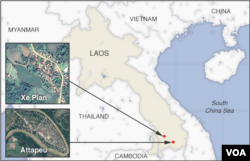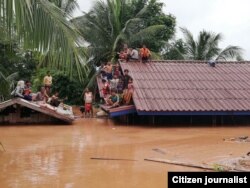Environmental groups and researchers are calling on the government of Laos to carry out an open investigation of the deadly collapse of a large dam.
On July 23, part of the Xe-Pian-Xe Namnoy hydropower dam collapsed releasing a wall of water. More than 20 people were killed, and as many as 6,000 were displaced by the floods.
The village of Attapeu in southern Laos received the most damage from the flooding.
Harming vulnerable people
Keith Barney is an expert in environmental research and natural resource policy in South East Asia at Australia’s National University. He said that governments often try to limit information after large disasters.
Barney told VOA, "The tendency in many cases when faced with difficult issues or external criticism is to cover up and shut down and block out the flow of information.” He added there are signs that this is happening in Laos, but it is being criticized and raising questions.
Satellite images from before the flood show Attapeu on a bend in the river with a network of roads. Pictures taken after the incident, however, show the flooded area as a brown mass of mud with few structures left.
Barney said that many of the people in the area are ethnic minorities who had already suffered from the dam building process. He said they may have been harmed by the downstream impact or may have been resettled. Barney added that this, “will just be adding on to their vulnerability in the coming year."
The Xe-Pian-Xe Namnoy dam is being built to create 410 megawatts of electricity near the Cambodian border. It is part of a series of dams Laos has planned or built to improve its economy by selling electricity to neighboring countries.
Non-governmental organizations have strongly opposed the country’s hydro power development. They say Laos has not made good safety plans for the social and environmental results of the projects.
of Mekong’s most important tributaries
The Xe-Pian-Xe Namnoy area feeds into the Sekong River. The organization Save the Mekong considers the river "one of the Mekong’s most important tributaries.”
In a statement, the group said the area is home "to tens of thousands of people from at least 20 different ethnic groups, all of whom rely on wild capture fisheries and surrounding forests and fertile lands."
Save the Mekong said a total of 11 large hydropower dams on the lower Mekong River and 120 tributary dams are planned.
Save the Mekong also said the recent dam disaster renews calls for the government to reconsider the country’s heavy investment in hydropower. It said the Laos governmentshould strengthen the enforcement of laws to guarantee greater responsibility from foreign investors.
The group also said water quality changes had ruined local fisheries along the Xe Pian River. But, it said villagers living there had not received any support for the loss of their livelihoods.
Barney said the collapse also raises questions about safety rules for building projects.
Many countries have donated aid to assist Laos with recovery and redevelopment. South Korea, Singapore, Vietnam, Malaysia and Australia have donated money and resources to the effort.
The intergovernmental Mekong River Commission released a statement to VOA. The group said it is "working to develop short- and medium-term programs to support Laos and other countries on dam safety” in partnership with the U.S. Army Corps of Engineers.
This week, the Laos government announced that it was suspending approval of new dams while it examines more than 50 current projects.
I’m Phil Dierking.
This story was originally written by Ron Corben for VOANews.com. Phil Dierking adapted the story for Learning English. Mario Ritter was the editor.
Do you think hydropower is worth the risk of harming nearby communities? Write to us in the Comments Section or on our Facebook page.
________________________________________________________________
Words in This Story
displaced - v. to force (people or animals) to leave the area where they live
tendency - n. a quality that makes something likely to happen or that makes someone likely to think or behave in a particular way
external - adj. located, seen, or used on the outside or surface of something
mud - n. soft, wet dirt
impact - n. a powerful or major influence or effect
vulnerability - n. easily hurt or harmed physically, mentally, or emotionally
tributaries - n. a stream that flows into a larger stream or river or into a lake










